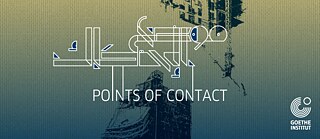Event series
Points of Contact
Points of Contact
27.01.-10.03.18

How does architecture construct the human bodily experience of everyday life? How is this bodily experience connected to capitalism and conflict? What are the points of contact between the human body, the architecture of the lived built environment and state and international governing forces? How can one problematize, resist or intervene in the evolution of this lived condition?
The exhibition and public program Points of Contact brings together multi-media responses and investigations into the architecture of the built environment in Lebanon, and its impact on a human bodily experience. The participating artists, theorists, activists, lawyers and architects will explore an interpenetration of private and public spheres that takes effect through capitalism and conflict. The exhibition will change and evolve over its duration, being constructed, and reconstructed as each participant will present their work through screenings, conversations, performances, lectures, and walking tours, taking place across two experimental roundtable events on January 27 and February 17, 2018. These events aim to create a platform for discussion between the participating projects as well as with the visiting audience.
The first experimental roundtable Body As Testimony, Poetics and Gender (January 27) pays particular attention to the affects of capitalism and conflict at the scale of the human body. Observing changes in the architecture of the built environment that take place in response to this human bodily experience. This event further questions how dominant methods of producing evidence or giving testimony can exclude or render the human body invisible? Proposing a possible turn towards the poetics of human testimony, asking what are the methods needed to engage a more inclusionary account of human bodily affect?
The second experimental roundtable Built Between the Slow, the Structural and the Spectacular (February 17) will observe a spectrum of methods that attempt to capture and evidence the slow, structural and spectacular violent affects of capitalism and conflict, seen through transformations in the architecture of the built environment. Asking how does the built environment or the architecture of the domestic space becomes an archive of such transformations? Further questioning how planning of the built environment becomes a way of speculating and projecting the affects of capitalism and conflict into the future?
In accompaniment to the main exhibition at the Media Lounge of Goethe-Institut Libanon, the Arab Center for Architecture will open as a satellite exhibition space on Saturday, February 17, 2018.
With the participation of: Shakeeb Abu Hamdan, George Arbid, Marwa Arsanios, Rayya Badran, Habib Battah, Vanessa Bowles, Hiba Farhat, Dima Hamadeh, Samar Kanafani, Helene Kazan, Jessika Khazrik, Fadi Mansour, Ayat Noureddine, Yoriko Otomo, Mohamed Safa, Rania Stephan, Sandra Schaefer.
A project by the Media Lounge of Goethe-Institut Libanon, curated by Helene Kazan, in collaboration with the Arab Center for Architecture and the British Council, Lebanon.
The exhibition and public program Points of Contact brings together multi-media responses and investigations into the architecture of the built environment in Lebanon, and its impact on a human bodily experience. The participating artists, theorists, activists, lawyers and architects will explore an interpenetration of private and public spheres that takes effect through capitalism and conflict. The exhibition will change and evolve over its duration, being constructed, and reconstructed as each participant will present their work through screenings, conversations, performances, lectures, and walking tours, taking place across two experimental roundtable events on January 27 and February 17, 2018. These events aim to create a platform for discussion between the participating projects as well as with the visiting audience.
The first experimental roundtable Body As Testimony, Poetics and Gender (January 27) pays particular attention to the affects of capitalism and conflict at the scale of the human body. Observing changes in the architecture of the built environment that take place in response to this human bodily experience. This event further questions how dominant methods of producing evidence or giving testimony can exclude or render the human body invisible? Proposing a possible turn towards the poetics of human testimony, asking what are the methods needed to engage a more inclusionary account of human bodily affect?
The second experimental roundtable Built Between the Slow, the Structural and the Spectacular (February 17) will observe a spectrum of methods that attempt to capture and evidence the slow, structural and spectacular violent affects of capitalism and conflict, seen through transformations in the architecture of the built environment. Asking how does the built environment or the architecture of the domestic space becomes an archive of such transformations? Further questioning how planning of the built environment becomes a way of speculating and projecting the affects of capitalism and conflict into the future?
In accompaniment to the main exhibition at the Media Lounge of Goethe-Institut Libanon, the Arab Center for Architecture will open as a satellite exhibition space on Saturday, February 17, 2018.
With the participation of: Shakeeb Abu Hamdan, George Arbid, Marwa Arsanios, Rayya Badran, Habib Battah, Vanessa Bowles, Hiba Farhat, Dima Hamadeh, Samar Kanafani, Helene Kazan, Jessika Khazrik, Fadi Mansour, Ayat Noureddine, Yoriko Otomo, Mohamed Safa, Rania Stephan, Sandra Schaefer.
A project by the Media Lounge of Goethe-Institut Libanon, curated by Helene Kazan, in collaboration with the Arab Center for Architecture and the British Council, Lebanon.